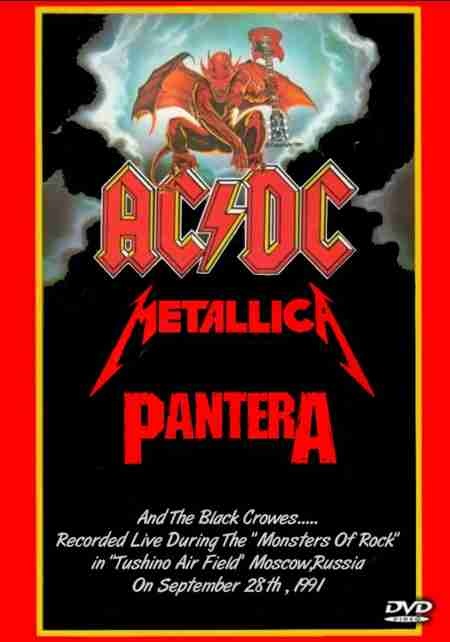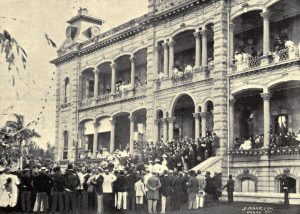What if I told you that one of the largest crowds to ever attend a concert—1.5 million people—happened in Russia?1 What if I told you that it was just before the fall of the Soviet Union? What if I told you that it was a heavy metal festival? Yes, this all happened in the fall of 1991, the very same year that the Iron Curtain fell. This is the story of the Monsters of Rock Moscow show.
The whole Monsters of Rock idea started in Castle Donington, England in 1980, gaining a monumental following in the following years, adding more popular bands in the rock and metal scene to the lineup. Although it was originally going to be a one-time event, over the next decade, the show was held again, and it only increased in popularity. It put on shows across Europe, cementing its place in music history.2

At the same time that Monsters of Rock was happening in Europe, the Soviet Union was in turmoil. During the 1980’s, Soviet Premier Lenoid Brezhnev died and by 1985, Mikhail Gorbachev had come to power. The Berlin Wall came down in 1989. Throughout the decade of the 1980s, western music was making its way into the USSR.
September 1991 was a big month in Russia. There was an August Coup, which was a failed military takeover of the Soviet Union.3 So, tensions were still high when the Russian government contacted the organizers of the show to see if they would be interested in having a show in Russia. Word of the show spread to many outlets, who wanted to see if they could televise the event, with Time Warner ending up getting the rights to record the show.

When it came to selecting the bands to perform, it was difficult to choose which bands would go. Because of Soviet isolation, the festival organizers did not know which bands would be popular in Russia. So, some of the most popular metal bands were chosen, bands such as AC/DC, Metallica, and Pantera, which became the main headliners for the show.4 The date for the event was set for September 28, in Tushino Airfield, a former site of Soviet military exercises.
On the day of the event, a flood of people came into the airfield early in the day, with events starting off at 2 p.m. with Pantera preforming first. The recordings of Pantera’s set can be seen online, capturing the loud and energetic atmosphere that the band was able to generate on their audience. The set that is remembered the most out of this event is Metallica’s. It was here that the estimated 1.5 million people showed up, causing chaos for the Soviet guards who were at the event.5 Video footage shows helicopters flying close to the crowd, trying to settle down the rowdy fans. In a video of the set, one can see the ocean of people moving around and singing along, even though the majority of the crowd only knew English through the music. You can feel the raw emotions of the crowd and see how one simple music event was able to draw in over 1.5 million, all through the power of music.

In December of 1991, a few months after the show had happened, the official dissolution of the Soviet Union took place.6 Many of the many restrictions on western media and music were gone and more events like the Monsters of Rock show were able to take place in the country. The legacy of the show is still known today. What was once thought of as a risk turned out to be one of the largest attended shows in history. It is truly beautiful how music was able to do this in a country where many restrictions on media did not allow this.
- Nathan Smith, “No Fences: Garth Brooks & the Fuzzy Math of 10 Mega-Concerts,” Houston Press, May 23, 2016, https://www.houstonpress.com/music/no-fences-garth-brooks-and-the-fuzzy-math-of-10-mega-concerts-6776412 . ↵
- Matt Wilkinson, “Plaque in Honour of Monsters Of Rock Co-founder Presented at Download.” NME, June 14, 2010, https://www.nme.com/news/music/download-festival-9-1291987 . ↵
- Jamie Glazov, “The Collapse of the Soviet Union: 25 Years Later,” Frontpage Magazine, December 26, 2016, https://www.frontpagemag.com/fpm/265260/collapse-soviet-union-25-years-later-jamie-glazov . ↵
- Nathan Smith, “No Fences: Garth Brooks & the Fuzzy Math of 10 Mega-Concerts.” Houston Press, May 23, 2016, https://www.houstonpress.com/music/no-fences-garth-brooks-and-the-fuzzy-math-of-10-mega-concerts-6776412 . ↵
- Brian Bumbery, “Metallica’s “Black Album” Sets New Sales Record,” Globe Newswire News Room, May 29, 2014, https://globenewswire.com/news-release/2014/05/29/1002715/0/en/Metallica-s-Black-Album-Sets-New-Sales-Record.html/ . ↵
- Jamie Glazov, “The Collapse of the Soviet Union: 25 Years Later,” Frontpage Magazine, December 26, 2016, https://www.frontpagemag.com/fpm/265260/collapse-soviet-union-25-years-later-jamie-glazov . ↵



53 comments
Eliezer Leal
It is truly amazing to see how music can bring people together. Although many people have their differences there is one thing that can defiantly bring people together, this being music. These three music titans, Metallica, AC/DC, and Pantera, are all well known throughout the world. Bringing a group of more than 1.5 million people is insane, but it just goes to show what effect music has on people.
Raul Vallejo
It’s crazy to even think about 1.5 million people together and it just blows my mind to imagine all of them screaming their favorite rock songs in unison. The amount of people there must have also been crazy for the performers to see that ridiculously large amount of people together in show. All while the country that this was happening in was falling apart.
Felipe Macias
One and a half million people does not sound like a real number. I think I’ve only met 2 thousand people in my life time, tops. At that point, 1.5 million people are just faces that don’t mean anything except they are all fans of heavy metal. Also, the genre of heavy metal achieving the highest number in audiences is not surprising; heavy metal somehow intrigues the brain very differently than any other type of music.
Elena
I remember hearing about The Monsters of Rock taking on the USSR just before the show. I was already a metalhead and wished mightily that I could’ve been there. The DIE chant during Creeping Death had to have been epic.
Hector Membreno
I have always been a huge fan and lover of music but never too into rock music. But it is crazy how AC/DC could get 1.5 million fans to attend a show in the USSR where these type of things and not like by the government. But not long after this show the many restrictions on western media and music were gone and more events like this occurred in the country. This shows that when people can come together whether its through music or other things change can occur.
Jose Chaman
Soviet history has always caught my eye. From human treatment to culture. In general, Soviet history was always very dark, full of secrets, mysteries, among other things. But I never imagined that one of the first international entry events before the fall of the Soviet Union was one of music, metal music to be specific, fact from which I’m fascinated. I completely agree with the author when he says that music has power and that is true (justified by the simple fact that more than a million people have attended the Monster of Rock), because it is said that music is about moving in the distance, opening new paths and, as in this case, making history! The video is also breathtaking, you can see a whole ocean of people! It must have been tremendous for the guest bands to play for that crowd.
Hali Garcia
Great article! I have actually never heard of this which is disappointing on my part because I really love music. It is amazing how music could bring people together and have such a positive impact during such dark times. What struck me was how they chose bands that they had no idea if the Russians would like and they still had a lot of people attending and enjoying the concert.
Cameron Lopez
I love AC/DC but I never knew about this, I’m very surprised that that the Soviet Union let the bands preform give with the restrictions on the western music in the country. Another thing I found interesting was that 1 and a half million people showed up for the Metallica’s performance. That Is so many people at one concert. Its much like Live aid back in 1985 there was about 200,000 people in person and it was broadcasted to about 1.5 billion people world wide. Although they’re watching from home that is still so many people watching on concert at one time.
Claudia Sanchez
I never would have thought of the Soviet Union having a large fan base for metal music, but because after reading the article it made a lot of sense as to why. Heavy metal is typically popular among those who want large societal change or have deep frustrations with society, which I assume those living in the Soviet Union during its collapse felt. Interesting article that examined the way music has a role in history which I really enjoyed reading!
Makenzie Santana
It is such a beautiful thing what music can do and the type of impact it has, I had no idea that metal music had taken place during a dark time for Russia. It is amazingly shocking that The Monsters of Rock were able to bring 1.5 million people to one place together for one of their shows, creating a famous marking point for themselves in the history of music.